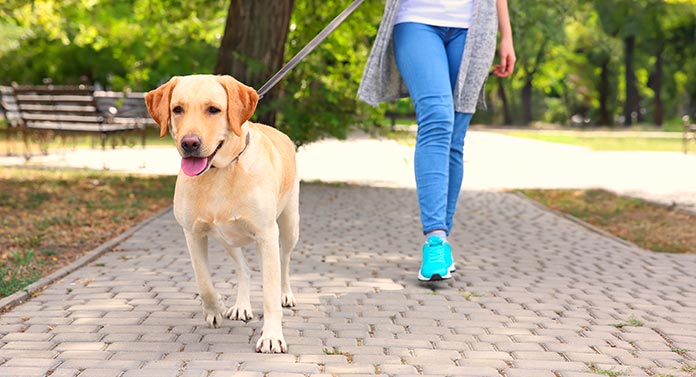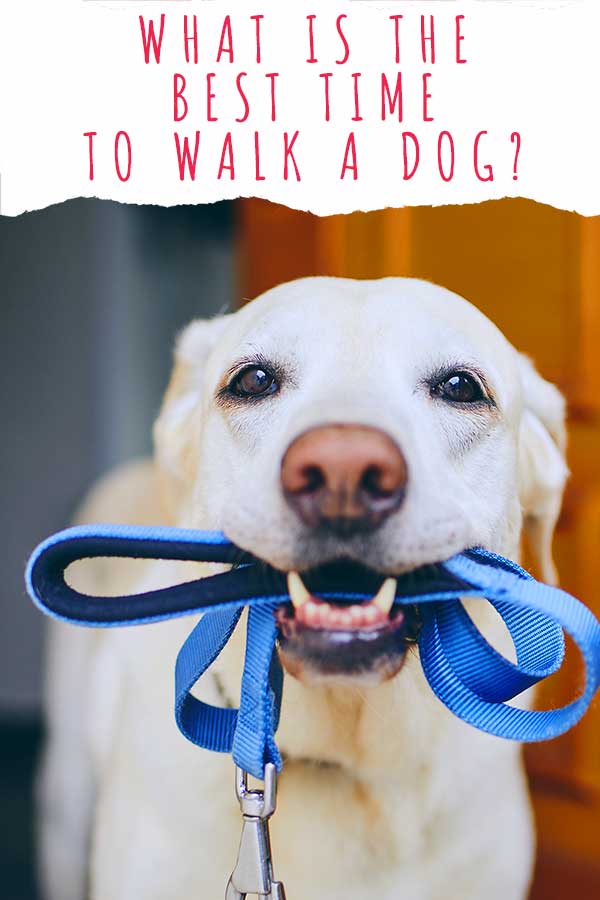
What is the best time to walk a dog in order to gain maximum benefit?
Many dogs are more settled at home if they start the day with a walk in the morning.
Most dogs need at least one more walk later in the day too.
Dog walks should always be timed to avoid hot weather, and they might also be more enjoyable when timed to avoid commuter rush hour, or popular dog walking times.
In this article, we examine how to time your dog’s walks to perfection.
The Importance Of Getting Enough Exercise
Finding enough convenient opportunities in the day to walk your dog isn’t just a kindness, it’s absolutely essential for their welfare.
Walks provide vital exercise, which is important for physical health.
Insufficient exercise is a risk factor for obesity in dogs.
And obesity, in turn, is a risk factor for other things which reduce their quality of life, such as
- heart disease
- pancreatitis
- and joint diseases.
Walks are also mentally enriching.
Just smelling new things, then mentally processing and organising what they’ve learned is a valuable way of meeting their need for stimulation.
Which makes them happier and more relaxed at home.
Choosing The Best Times Of Day To Walk A Dog
Most dogs don’t just need one opportunity to stretch their legs, they need two, or even more!

Several things influence how many times a day you’ll need to find to walk your dog.
1. Their breed
Different breeds have different exercise needs to maintain optimal health.
Working dog breeds with lots of physical stamina need more frequent outlets for their physical energy.
Without it, they’re prone to getting bored and frustrated, which they may express through destructive behaviors around the home.
Examples of these breeds include Siberian Huskies, English Springer Spaniels, Dalmatians, and Nova Scotia Duck Tolling Retrievers.
On the other hand, racing dogs like Greyhounds and Whippets were bred for bursts of incredible speed, but not endurance.
One good chance to sprint might be all the exertion they require
before they retire to the sofa for the rest of the day.
2. Your home
Of course, getting outdoors isn’t just about exercise for a dog – it’s their time for using the toilet too.
And due to this, how many times a day we walk our dogs, is, unsurprisingly, linked to the kind of home we live in.
Apartment dwellers tend to take their dogs for shorter, more frequent walks, so that their dogs get enough chances to pee and poop.
Whilst dog owners who live in a house with a yard are more likely to take their dog for fewer, longer walks, and let them take their remaining toilet breaks in the yard.
3. Your lifestyle
The number of walks your dog needs (and how you stagger them through the day) also depends on lifestyle factors such as whether you work, have kids, etc.
We tend to spend more time walking our dogs when:
- they’re the only dog in the household
- they’re medium or large, rather than small
- we live alone, or in a small human household
- and if we got them to complement a hobby.
For lots of dog owners, balancing the needs and expectations of a human family and the best interests of a dog involves a bit of trial and error.
And this includes working out when to schedule walkies.
But we can also help you make an informed decision about where to begin.
What Is The Best Time To Walk A Dog? Morning Vs Evening
Assuming your dog is going to have one or two main walk(s) per day, what are the pros and cons of getting out first thing vs later in the day?
Let’s weigh them up.
Morning
First thing in the morning is a popular time for walking the dog.
It’s when they’re most rested and looking for something to do, so getting them outdoors now avoids them getting fidgety and frustrated at home.
In summer, getting out early in the morning also avoids the hottest part of the day.
And, lots of dog owners report that fresh air and exercise first thing in the morning sets them up well for the day too.
On the downside, urban areas are likely to be busy with commuters and kids on their way to school. Dog parks are also likely to be busy.
Depending on your region, it might not always be light at the time you have in mind either.
Afternoon
Say you want to avoid the early morning crowds, and you’re not an early riser anyway, what about waiting until after lunch?
Afternoons are usually a reasonably quiet time of day to walk your dog.
Some dogs may not mind waiting a bit longer for their main walk either, provided they had an earlier chance to pee and poop.
Older dogs and senior pets in particular tend to have less urgent exercise demands!
However, afternoons are usually the hottest time of day as well.
If you live in a region which enjoys lots of good weather, venturing out for long walks in the midday sun might not be safe for your dog (more on that in a minute).
Evening
What could be better than winding down at the end of the day with a walk?
Evenings are a lovely time of day to walk your dog, but a lot of dogs will struggle to wait that long for their main walk without getting bored and restless around the home.
It’s a great time for a second walk in addition to a morning walk, though.
And some dog owners swear by an evening walk as a way to signal to their dog that the day is nearly done.
It says “we’re going for this walk, then having dinner, and watching a bit of TV together on the sofa before bed”.
Their dog learns the routine and understands what’s expected from them at every step of the way.
Walking is also a good way of triggering a final bowel movement before bed!
Depending on how late you take your evening walk, and the daylight hours in your region, don’t forget to think about safety.
Invest in some reflective or illuminated gear for you and your dog, and make sure someone else knows which route you’re taking, and what time you’ll be back.
Times To Avoid Walking A Dog
Choosing the best time to walk a dog also avoids impractical or dangerous times of day.
For example:
Mid-afternoon in August in Florida
And other extremely hot times.
Dogs rely on panting to regulate their body temperature, and they are vulnerable to overheating when they can’t cool down efficiently enough to cope with the climate.
Some dogs are particularly at risk of heat stroke, which can be fatal:
- Dogs with heavy double coats.
- Those who are overweight.
- And dogs with flat faces, like Pugs and French Bulldogs.
After a meal
Also avoid doing vigorous exercise with your dog immediately after a meal.
Exercising after a meal is a risk factor for gastric dilatation volvulus, better known as bloat.
Bloat occurs when the stomach flips over. The esophagus at the entrance of the stomach and the small intestine at the exit end up with twists in them, so that nothing can enter or leave the stomach chamber.
This condition is fatal, unless it is corrected by surgery.
At risk breeds include German Shepherds, Great Danes, Greyhounds, Labradors, and other deep chested dogs.
The Importance Of Being Consistent
Q: What is the best time to walk a dog?
A: The same time every day!
It’s true. Once you’ve worked out a safe, practical time of day to walk your dog, try to stick to that time as consistently as possible.
The reason is that dogs really love routine.
When they know what’s going to happen during each part of the day, they can learn what’s expected of them, and how to behave at each point.
When we reward them for getting it right, they gain confidence and relax because they’re feeling confident.
At every stage, this is good for them, and us!
However, don’t be a slave to your usual routine if something makes it unworkable.
For example, you can always move your lunchtime walk to earlier or later in the day, if your location experiences a heatwave.
What Is The Best Time To Walk A Dog – Summary
The best time of day is unique to everyone and their own dog.
Some dogs just need one perfect time to walk, whilst others need lots of opportunities for exercise.
Finding a time which suits you and creating your own daily ritual together with your dog is part of the joy of owning them.
When do you and your dog like to walk?
Let us know in the comments box down below!
Readers Also Liked
References
Bland et al. Dog obesity: Veterinary practices’ and owners’ opinions on cause and management. Preventative Veterinary Medicine. 2010.
Davis et al. Effect of brachycephaly and body condition score on respiratory thermoregulation of healthy dogs. Journal of the American Veterinary Medical Association. 2017.
Degeling et al. An investigation of the association between socio-demographic factors, dog-exercise requirements, and the amount of walking dogs receive. Canadian Journal of Veterinary Research. 2012.
Murtagh et al. The scent of enrichment: Exploring the effect of odour and biological salience on behaviour during enrichment of kennelled dogs. Applied Animal Behaviour Science. 2020.
Westgarth et al. Factors associated with daily walking of dogs. BMC Veterinary Research. 2015.

Free Training Tips
Get Pippa's free dog training tips delivered to your inbox

 What Is A Companion Dog?
What Is A Companion Dog?